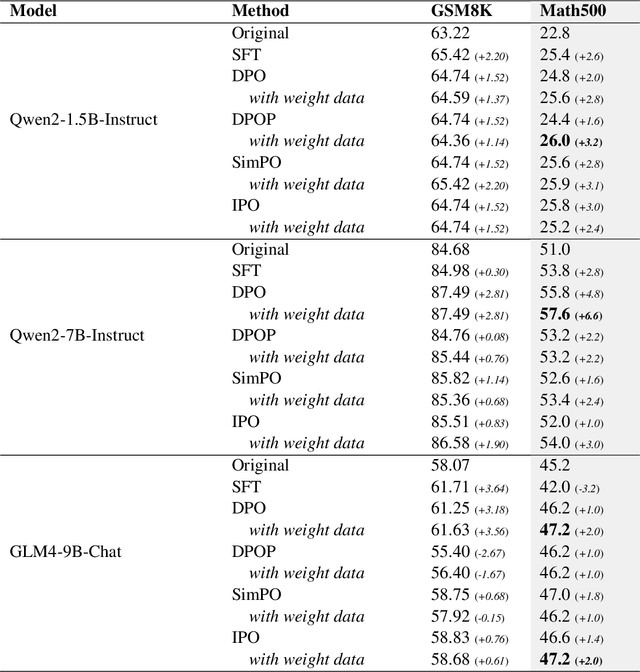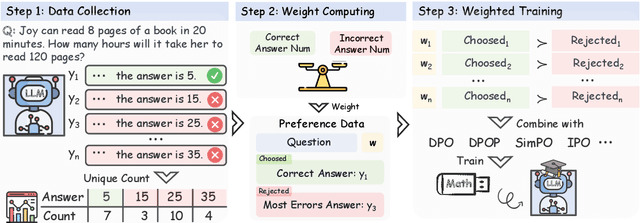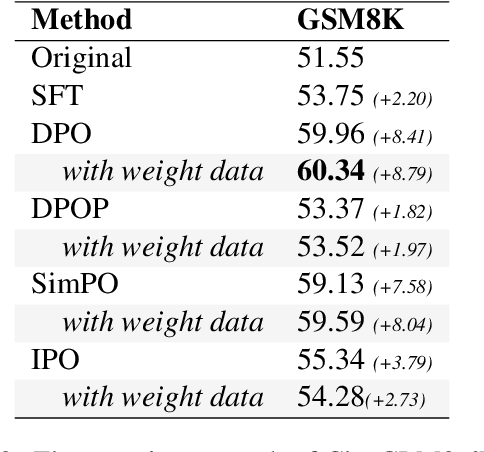Lei Sha
HauntAttack: When Attack Follows Reasoning as a Shadow
Jun 08, 2025Abstract:Emerging Large Reasoning Models (LRMs) consistently excel in mathematical and reasoning tasks, showcasing exceptional capabilities. However, the enhancement of reasoning abilities and the exposure of their internal reasoning processes introduce new safety vulnerabilities. One intriguing concern is: when reasoning is strongly entangled with harmfulness, what safety-reasoning trade-off do LRMs exhibit? To address this issue, we introduce HauntAttack, a novel and general-purpose black-box attack framework that systematically embeds harmful instructions into reasoning questions. Specifically, we treat reasoning questions as carriers and substitute one of their original conditions with a harmful instruction. This process creates a reasoning pathway in which the model is guided step by step toward generating unsafe outputs. Based on HauntAttack, we conduct comprehensive experiments on multiple LRMs. Our results reveal that even the most advanced LRMs exhibit significant safety vulnerabilities. Additionally, we perform a detailed analysis of different models, various types of harmful instructions, and model output patterns, providing valuable insights into the security of LRMs.
Towards Harmonized Uncertainty Estimation for Large Language Models
May 25, 2025Abstract:To facilitate robust and trustworthy deployment of large language models (LLMs), it is essential to quantify the reliability of their generations through uncertainty estimation. While recent efforts have made significant advancements by leveraging the internal logic and linguistic features of LLMs to estimate uncertainty scores, our empirical analysis highlights the pitfalls of these methods to strike a harmonized estimation between indication, balance, and calibration, which hinders their broader capability for accurate uncertainty estimation. To address this challenge, we propose CUE (Corrector for Uncertainty Estimation): A straightforward yet effective method that employs a lightweight model trained on data aligned with the target LLM's performance to adjust uncertainty scores. Comprehensive experiments across diverse models and tasks demonstrate its effectiveness, which achieves consistent improvements of up to 60% over existing methods.
AISafetyLab: A Comprehensive Framework for AI Safety Evaluation and Improvement
Feb 24, 2025Abstract:As AI models are increasingly deployed across diverse real-world scenarios, ensuring their safety remains a critical yet underexplored challenge. While substantial efforts have been made to evaluate and enhance AI safety, the lack of a standardized framework and comprehensive toolkit poses significant obstacles to systematic research and practical adoption. To bridge this gap, we introduce AISafetyLab, a unified framework and toolkit that integrates representative attack, defense, and evaluation methodologies for AI safety. AISafetyLab features an intuitive interface that enables developers to seamlessly apply various techniques while maintaining a well-structured and extensible codebase for future advancements. Additionally, we conduct empirical studies on Vicuna, analyzing different attack and defense strategies to provide valuable insights into their comparative effectiveness. To facilitate ongoing research and development in AI safety, AISafetyLab is publicly available at https://github.com/thu-coai/AISafetyLab, and we are committed to its continuous maintenance and improvement.
Be a Multitude to Itself: A Prompt Evolution Framework for Red Teaming
Feb 22, 2025Abstract:Large Language Models (LLMs) have gained increasing attention for their remarkable capacity, alongside concerns about safety arising from their potential to produce harmful content. Red teaming aims to find prompts that could elicit harmful responses from LLMs, and is essential to discover and mitigate safety risks before real-world deployment. However, manual red teaming is both time-consuming and expensive, rendering it unscalable. In this paper, we propose RTPE, a scalable evolution framework to evolve red teaming prompts across both breadth and depth dimensions, facilitating the automatic generation of numerous high-quality and diverse red teaming prompts. Specifically, in-breadth evolving employs a novel enhanced in-context learning method to create a multitude of quality prompts, whereas in-depth evolving applies customized transformation operations to enhance both content and form of prompts, thereby increasing diversity. Extensive experiments demonstrate that RTPE surpasses existing representative automatic red teaming methods on both attack success rate and diversity. In addition, based on 4,800 red teaming prompts created by RTPE, we further provide a systematic analysis of 8 representative LLMs across 8 sensitive topics.
How Far are LLMs from Being Our Digital Twins? A Benchmark for Persona-Based Behavior Chain Simulation
Feb 20, 2025Abstract:Recently, LLMs have garnered increasing attention across academic disciplines for their potential as human digital twins, virtual proxies designed to replicate individuals and autonomously perform tasks such as decision-making, problem-solving, and reasoning on their behalf. However, current evaluations of LLMs primarily emphasize dialogue simulation while overlooking human behavior simulation, which is crucial for digital twins. To address this gap, we introduce BehaviorChain, the first benchmark for evaluating LLMs' ability to simulate continuous human behavior. BehaviorChain comprises diverse, high-quality, persona-based behavior chains, totaling 15,846 distinct behaviors across 1,001 unique personas, each with detailed history and profile metadata. For evaluation, we integrate persona metadata into LLMs and employ them to iteratively infer contextually appropriate behaviors within dynamic scenarios provided by BehaviorChain. Comprehensive evaluation results demonstrated that even state-of-the-art models struggle with accurately simulating continuous human behavior.
Reasoning-to-Defend: Safety-Aware Reasoning Can Defend Large Language Models from Jailbreaking
Feb 18, 2025Abstract:The reasoning abilities of Large Language Models (LLMs) have demonstrated remarkable advancement and exceptional performance across diverse domains. However, leveraging these reasoning capabilities to enhance LLM safety against adversarial attacks and jailbreak queries remains largely unexplored. To bridge this gap, we propose Reasoning-to-Defend (R2D), a novel training paradigm that integrates safety reflections of queries and responses into LLMs' generation process, unlocking a safety-aware reasoning mechanism. This approach enables self-evaluation at each reasoning step to create safety pivot tokens as indicators of the response's safety status. Furthermore, in order to improve the learning efficiency of pivot token prediction, we propose Contrastive Pivot Optimization(CPO), which enhances the model's ability to perceive the safety status of dialogues. Through this mechanism, LLMs dynamically adjust their response strategies during reasoning, significantly enhancing their defense capabilities against jailbreak attacks. Extensive experimental results demonstrate that R2D effectively mitigates various attacks and improves overall safety, highlighting the substantial potential of safety-aware reasoning in strengthening LLMs' robustness against jailbreaks.
Plug-and-Play Training Framework for Preference Optimization
Dec 30, 2024



Abstract:Recently, preference optimization methods such as DPO have significantly enhanced large language models (LLMs) in wide tasks including dialogue and question-answering. However, current methods fail to account for the varying difficulty levels of training samples during preference optimization, leading to mediocre performance in tasks with high accuracy requirements, particularly in mathematical reasoning. To address this limitation, we propose a novel training framework, which employs multiple sampling to analyze output distributions, assign different weights to samples, and incorporate these weights into the preference optimization process. This plug-and-play approach enables LLMs to prioritize challenging examples during training, improving learning efficiency. Experimental results demonstrate that our framework integrates seamlessly with various preference optimization methods and achieves consistent improvements in mathematical reasoning tasks.
DiffusionAttacker: Diffusion-Driven Prompt Manipulation for LLM Jailbreak
Dec 23, 2024



Abstract:Large Language Models (LLMs) are susceptible to generating harmful content when prompted with carefully crafted inputs, a vulnerability known as LLM jailbreaking. As LLMs become more powerful, studying jailbreak methods is critical to enhancing security and aligning models with human values. Traditionally, jailbreak techniques have relied on suffix addition or prompt templates, but these methods suffer from limited attack diversity. This paper introduces DiffusionAttacker, an end-to-end generative approach for jailbreak rewriting inspired by diffusion models. Our method employs a sequence-to-sequence (seq2seq) text diffusion model as a generator, conditioning on the original prompt and guiding the denoising process with a novel attack loss. Unlike previous approaches that use autoregressive LLMs to generate jailbreak prompts, which limit the modification of already generated tokens and restrict the rewriting space, DiffusionAttacker utilizes a seq2seq diffusion model, allowing more flexible token modifications. This approach preserves the semantic content of the original prompt while producing harmful content. Additionally, we leverage the Gumbel-Softmax technique to make the sampling process from the diffusion model's output distribution differentiable, eliminating the need for iterative token search. Extensive experiments on Advbench and Harmbench demonstrate that DiffusionAttacker outperforms previous methods across various evaluation metrics, including attack success rate (ASR), fluency, and diversity.
Derail Yourself: Multi-turn LLM Jailbreak Attack through Self-discovered Clues
Oct 14, 2024



Abstract:This study exposes the safety vulnerabilities of Large Language Models (LLMs) in multi-turn interactions, where malicious users can obscure harmful intents across several queries. We introduce ActorAttack, a novel multi-turn attack method inspired by actor-network theory, which models a network of semantically linked actors as attack clues to generate diverse and effective attack paths toward harmful targets. ActorAttack addresses two main challenges in multi-turn attacks: (1) concealing harmful intents by creating an innocuous conversation topic about the actor, and (2) uncovering diverse attack paths towards the same harmful target by leveraging LLMs' knowledge to specify the correlated actors as various attack clues. In this way, ActorAttack outperforms existing single-turn and multi-turn attack methods across advanced aligned LLMs, even for GPT-o1. We will publish a dataset called SafeMTData, which includes multi-turn adversarial prompts and safety alignment data, generated by ActorAttack. We demonstrate that models safety-tuned using our safety dataset are more robust to multi-turn attacks. Code is available at https://github.com/renqibing/ActorAttack.
BlackDAN: A Black-Box Multi-Objective Approach for Effective and Contextual Jailbreaking of Large Language Models
Oct 13, 2024



Abstract:While large language models (LLMs) exhibit remarkable capabilities across various tasks, they encounter potential security risks such as jailbreak attacks, which exploit vulnerabilities to bypass security measures and generate harmful outputs. Existing jailbreak strategies mainly focus on maximizing attack success rate (ASR), frequently neglecting other critical factors, including the relevance of the jailbreak response to the query and the level of stealthiness. This narrow focus on single objectives can result in ineffective attacks that either lack contextual relevance or are easily recognizable. In this work, we introduce BlackDAN, an innovative black-box attack framework with multi-objective optimization, aiming to generate high-quality prompts that effectively facilitate jailbreaking while maintaining contextual relevance and minimizing detectability. BlackDAN leverages Multiobjective Evolutionary Algorithms (MOEAs), specifically the NSGA-II algorithm, to optimize jailbreaks across multiple objectives including ASR, stealthiness, and semantic relevance. By integrating mechanisms like mutation, crossover, and Pareto-dominance, BlackDAN provides a transparent and interpretable process for generating jailbreaks. Furthermore, the framework allows customization based on user preferences, enabling the selection of prompts that balance harmfulness, relevance, and other factors. Experimental results demonstrate that BlackDAN outperforms traditional single-objective methods, yielding higher success rates and improved robustness across various LLMs and multimodal LLMs, while ensuring jailbreak responses are both relevant and less detectable.
 Add to Chrome
Add to Chrome Add to Firefox
Add to Firefox Add to Edge
Add to Edge